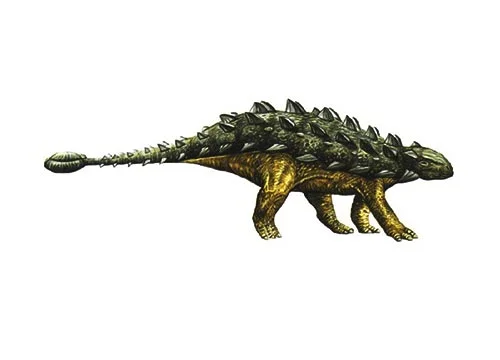Talarurus (Wicker basket tail)

Tal-ah-roo-russ
Evgeny Maleev - 1952
Herbivore
Estimated 5 meters long
Armoured Dinosaur
T. plicatospineus (type)
Mongolia - Bayan Shireh Formation
Late Cretaceous, 70-68 million years ago
Talarurus Facts
Talarurus is a genus of ankylosaurid dinosaur that lived during the Late Cretaceous period, around 70-68 million years ago. Its fossils have been found in what is now modern-day Mongolia. The name Talarurus means “wicker tail” in reference to the unique shape of its tail club.
Talarurus was a herbivorous dinosaur, and it had a heavily-armored body with bony plates and spikes covering much of its skin. Its back was lined with rows of small, knob-like osteoderms, and larger spikes protruded from its shoulders and hips. However, the most distinctive feature of Talarurus was its tail club, which was made up of several rows of tightly packed, elongated bony spikes that gave it the appearance of a wicker basket. This tail club was likely used for defense against predators, as well as for display during mating rituals.
Talarurus was a relatively small ankylosaurid, measuring around 16 feet (5 meters) in length and weighing around 1-2 tons. It had a broad, flat head with a beak-like mouth, which it used to strip vegetation from branches and leaves. Its teeth were small and leaf-shaped, and it had a relatively weak bite force compared to some other ankylosaurids.
Talarurus likely lived in a semi-arid environment, and would have shared its habitat with other Late Cretaceous dinosaurs like Velociraptor, Protoceratops, and Tarbosaurus. It may have also faced competition from other ankylosaurids, like Pinacosaurus and Ankylosaurus.
The fossils of Talarurus have helped scientists to learn more about the evolution and behavior of ankylosaurid dinosaurs. For example, the unique structure of its tail club has given us insight into the diversity of defensive adaptations that evolved in these armored dinosaurs. Additionally, the discovery of Talarurus fossils in Mongolia has helped to shed light on the biogeography of the region during the Late Cretaceous period.
Overall, Talarurus is a fascinating dinosaur that played an important role in the ecosystem of its time. Its armored body and unique tail club make it a fascinating subject for paleontologists and dinosaur enthusiasts alike.



